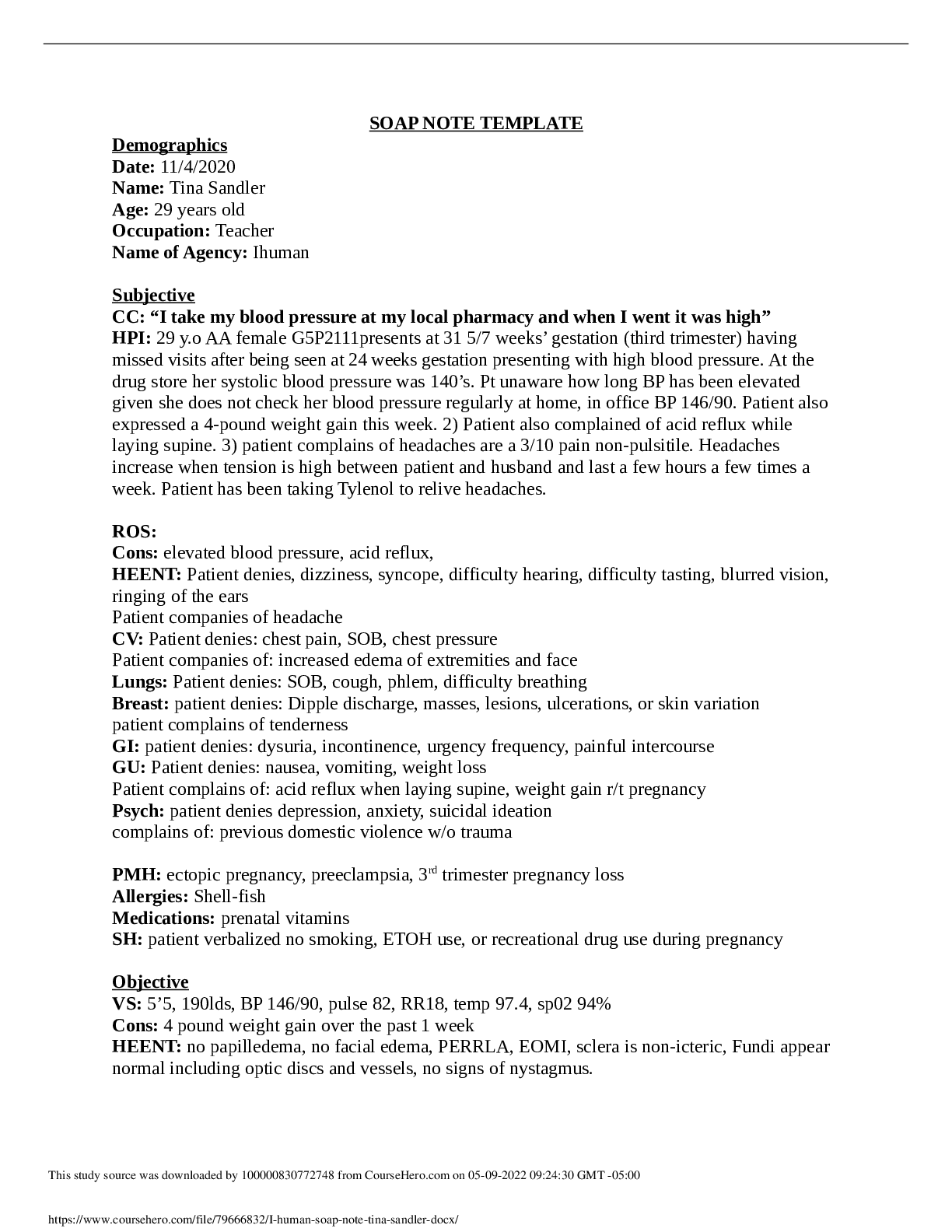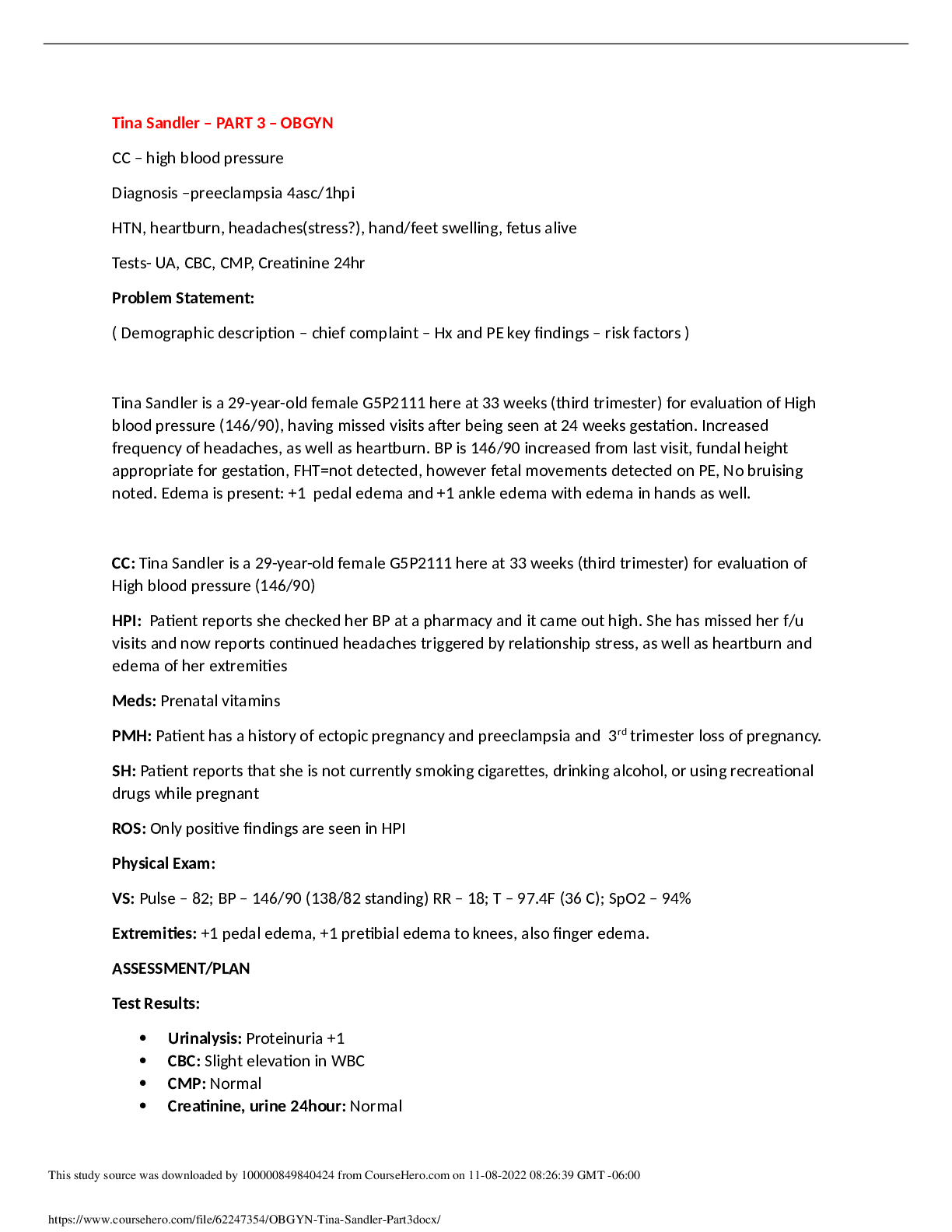Health Care > CASE STUDY > Robertson Case Study week 5 (All)
Robertson Case Study week 5
Document Content and Description Below
CASE STUDY 1 Case Study: Diabetes Courtney Robertson Chamberlain College of Nursing NR601: Primary Care of the Maturing and Aged Family March 2019 CASE STUDY 2 Case Study: Diabetes The purpos... e of this paper is to analyze the objective and subjective data provided by a case study on Mrs. G from her annual exam. After evaluation an appropriate diagnosis, treatment, and management plan per the latest national guidelines will be developed including cost of medications. The information collected through out the exam will be placed into a SOAP note format with and individualized plan made and presented per Mrs. G’s findings. Assessment In the reviewed case study of Mrs. G’s annual exam we find a Hispanic 56 year old female who has presented with increased fatigue, weight gain, increased hunger and thirst, and increased urination. She has no history of which would be significant of the above-mentioned symptoms. Objective data collected and presented in this case study together with the abovementioned symptoms are used in decision to diagnose the patient appropriately. Primary Diagnosis Type 2 Diabetes Mellitus (E11) was chosen as the primary diagnosis based on the national diabetes guidelines from the American Diabetes Association [ADA] (2019). According to the recommended criteria a Hgb A1C > 6.5%, a fasting plasma glucose (FPG) > 126, a 2-h plasma glucose > 200, or the presence of symptoms of hyperglycemia such as polyuria, polydipsia, polyphagia plus a random PG > 200 can be used to diagnose (ADA, 2019). If using an A1C, 2-H plasma glucose, or FPG alone a repeated test should be done without delay with a second blood sample to confirm the diagnosis of T2DM (ADA, 2019). Signs and symptoms related to T2DM are polyuria, polydipsia, increased hunger, blurred vision, numbness or tingling in hands or feet, slow healing wounds, or increase of infections (ADA, 2019). Risk factors are CASE STUDY 3 related to family history of T2DM, age >45, ethnicity of Hispanic, African American, American Indian, or Alaskan, history of gestational diabetes, obesity, and a sedentary lifestyle (ADA, 2019). The American Diabetes Association recommends screening for those >45 and overweight or obesity with at least one other risk factor (ADA, 2019). Pathophysiology. Type 2 Diabetes Mellitus is caused by a decrease in insulin secretion due to abnormal B-cell function (ADA, 2019). Signs and symptoms of T2DM are fatigue, frequent urination, increased hunger, increased thirst, pain or tingling in hands and feet, and slow healing wounds (ADA, 2019). pertinent positive findings. The rationale for this diagnoses is based on her pertinent positive objective findings of Hgb A1C of 6.9%, glucose in her urine, protein in urine, total cholesterol 230mg/dl; LDL 144 mg/dl; VLDL 36; HDL 38 mg/dl; Triglycerides; 232, height 5’2”, weight 185 pounds, and elevated blood pressure 129/80 (ADA, 2019). Signs and symptoms of fatigue, polyuria, polydipsia, increased hunger, obesity, and birth weight of her child 9lbs 2 oz. which is indicative of gestational diabetes and also puts her at a higher risk for developing T2DM (ADA, 2019). pertinent negative findings. Pertinent negative findings would be blood glucose of 95, blurred vision, slow healing wounds, or known family history as indicated by the American Diabetic Association (2019). rationale for the diagnosis. The subjective and objective findings with in this case study that were used to diagnose Mrs. G with T2DM are a Hgb A1C of 6.9%, abnormal lipid panel, glucose and protein in urine, fatigue, obesity, polyuria, polydipsia, and increased hunger (ADA, 2019). The risk for development are greatly increased with age, elevated CASE STUDY 4 blood pressure, increased BMI, women with likely hood of gestational diabetes, dyslipidemia, and Hispanic ethnicity, the screening tool of her Hgb A1C value follows recommended guidelines to diagnose her with T2DM (ADA, 2019). Secondary Diagnosis Hyperlipidemia (E78.5) according to the American College of Cardiology and American Heart Association (ACC/AHA) guidelines can be diagnosed with a total cholesterol (TC) > 200; LDL >100; HDL<40; TG >150 (Grundy et al., 2018). Abnormal results increase the risk of atherosclerosis and can present asymptomatic or with a carotid bruit, corneal arcus, or xanthomas (Dixit et al., 2014). Hyperlipidemia is one of the leading risk factors for cardiovascular disease (Dixit et al., 2014). Elevated Blood Pressure (R03.0) is diagnosed per the national guidelines provided by the American College of Cardiology and the American Heart Association (ACC/AHA) that a blood pressure reading of 120-129mm hg systolic and less than 80mm hg diastolic is considered an elevated reading (Whelton et al., 2018). Systolic blood pressure (SBP) of 130-139mm hg and a diastolic blood pressure (DBP) of 80-89mm hg classify as Stage 1 Hypertension and a SBP of at least 140mm hg and DBP of at least 90mm hg is diagnosed as Stage 2 Hypertension (Whelton et el., 2018). Arthritis (M13.86) diagnosis is based on Mrs. G’s medical history of arthritis of the left knee. According to the American College of Rheumatology (ACR) the guidelines for diagnosis can be made by clinical assessment alone or in addition to radiographic imaging which would show a narrowing of the joint space, osteophytes, sclerosis, and subchondral cysts but these are typically seen later in the diagnosis (Kolasinski et al., 2017). The typical symptoms present as CASE STUDY 5 stiffness of joint in the morning or after inactivity, limited range of motion, and swelling in the affected joint (Kolasinski et al., 2017). Risk factors are aging, women more likely than men, and previous injury to the joint, obesity, or an occupation that would have placed strain on weight bearing joints (Kolasinski et al., 2017) [Show More]
Last updated: 2 years ago
Preview 1 out of 21 pages

Buy this document to get the full access instantly
Instant Download Access after purchase
Buy NowInstant download
We Accept:

Reviews( 0 )
$7.00
Can't find what you want? Try our AI powered Search
Document information
Connected school, study & course
About the document
Uploaded On
Apr 30, 2022
Number of pages
21
Written in
Additional information
This document has been written for:
Uploaded
Apr 30, 2022
Downloads
0
Views
83


 (1).png)













